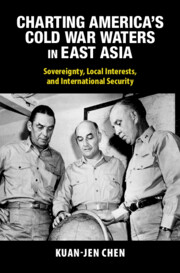 Charting America's Cold War Waters in East Asia
Charting America's Cold War Waters in East Asia Published online by Cambridge University Press: 23 May 2024
The author takes a detailed look at decision-makers’ plans for unified commands in the Pacific from 1947 onwards and elaborates on the debates within the Truman administration over naval deployment in post-war East Asia and its overall international security goals. The author further argues that the wartime competition for leadership in the Pacific between MacArthur and Nimitz did not end with World War II but persisted in the immediate post-war period. The United States regarded the Pacific as its lake, but the United States’ Navy–Army division resulted in it being a divided lake in terms of authority: the Army led the Far East Command and the Navy held the Pacific Command according to the 1947 unified command plan. This chapter also shows the inextricable link between international and regional turbulence and America’s construction of unified commands in the Pacific. Mainland China, which the US Navy chose as a springboard where it could build its maritime order in post-war East Asia, was not included in either the Far East Command or the Pacific Command. Truman administration’s ambiguous China policy and the Navy–Army competition for leadership in the Pacific blurred the contours of America’s maritime East Asia.
To save this book to your Kindle, first ensure no-reply@cambridge.org is added to your Approved Personal Document E-mail List under your Personal Document Settings on the Manage Your Content and Devices page of your Amazon account. Then enter the ‘name’ part of your Kindle email address below. Find out more about saving to your Kindle.
Note you can select to save to either the @free.kindle.com or @kindle.com variations. ‘@free.kindle.com’ emails are free but can only be saved to your device when it is connected to wi-fi. ‘@kindle.com’ emails can be delivered even when you are not connected to wi-fi, but note that service fees apply.
Find out more about the Kindle Personal Document Service.
To save content items to your account, please confirm that you agree to abide by our usage policies. If this is the first time you use this feature, you will be asked to authorise Cambridge Core to connect with your account. Find out more about saving content to Dropbox.
To save content items to your account, please confirm that you agree to abide by our usage policies. If this is the first time you use this feature, you will be asked to authorise Cambridge Core to connect with your account. Find out more about saving content to Google Drive.